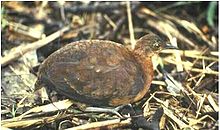- Grey-legged Tinamou
-
Grey-legged Tinamou Conservation status Scientific classification Kingdom: Animalia Phylum: Chordata Class: Aves Order: Tinamiformes Family: Tinamidae Subfamily: Tinaminae Genus: Crypturellus Species: C. duidae Binomial name Crypturellus duidae
(Zimmer, 1938)[2]The Grey-legged Tinamou, Crypturellus duidae, is a species of tinamou found in relatively dry, shrubby forests in the Amazon in South America.[3]
Contents
Taxonomy
The Grey-legged Tinamou is a monotypic species.[3] All tinamou are from the family Tinamidae, and in the larger scheme are also Ratites. Unlike other Ratites, Tinamous can fly, although in general, they are not strong fliers. All ratites evolved from prehistoric flying birds, and Tinamous are the closest living relative of these birds.[4]
Etymology
Crypturellus is formed from three Latin or Greek words. kruptos meaning covered or hidden, oura meaning tail, and ellus meaning diminutive. Therefore Crypturellus means small hidden tail.[5]
Description
The Grey-legged Tinamou is approximately 30 cm (12 in) in length. It is dark brown above with finely barred black on its lower back, it is rufous below, has tinged grey on its upper breast, the sides of its belly are banded buff, its head and neck are rufous, its throat white, and its legs are greyish. The female is darker on her lower back with narrow light buff barring.[citation needed]
Behavior
Like other tinamous, the Grey-legged Tinamou eats fruit off the ground or low-lying bushes. They also eat small amounts of invertebrates, flower buds, tender leaves, seeds, and roots. The male incubates the eggs which may come from as many as 4 different females, and then will raise them until they are ready to be on their own, usually 2–3 weeks. The nest is located on the ground in dense brush or between raised root buttresses.[4]
Range and habitat
It is found in dry shrubland up to 500 m (1,600 ft) altitude. It may also be found in moist or drier lowland forest. This species is native to east central Colombia, southern Venezuela, and northwestern Brazil.[3] It may also be found in far eastern Peru.[6]
Conservation
The IUCN classifies this Tinamou as Least Concern,[1] with an occurrence range of 59,000 km2 (23,000 sq mi).[6]
Footnotes
References
- BirdLife International (2008). Crypturellus duidae. 2006. IUCN Red List of Threatened Species. IUCN 2006. www.iucnredlist.org. Retrieved on 04 Feb 2009.
- BirdLife International (2008(a)). "Grey-legged Tinamou - BirdLife Species Factsheet". Data Zone. http://www.birdlife.org/datazone/species/index.html?action=SpcHTMDetails.asp&sid=33&m=1. Retrieved 06 Feb 2009.
- Brands, Sheila (Aug 14 2008). "Systema Naturae 2000 / Classification, Genus Crypturellus". Project: The Taxonomicon. http://www.taxonomy.nl/Main/Classification/51327.htm. Retrieved Feb 04 2009.
- Clements, James (2007). The Clements Checklist of the Birds of the World (6 ed.). Ithaca, NY: Cornell University Press. ISBN 978 0 8014 4501 9.
- Davies, S.J.J.F. (2003). "Tinamous". In Hutchins, Michael. Grzimek's Animal Life Encyclopedia. 8 Birds I Tinamous and Ratites to Hoatzins (2 ed.). Farmington Hills, MI: Gale Group. pp. 57–59. ISBN 0 7876 5784 0.
- Gotch, A. F. (1995) [1979]. "Tinamous". Latin Names Explained. A Guide to the Scientific Classifications of Reptiles, Birds & Mammals. New York, NY: Facts on File. p. 183. ISBN 0 8160 3377 3.
Tinamous (order: Tinamiformes • family: Tinamidae) Subfamily Tinaminae Berlepsch's Tinamou • Little Tinamou • Cinereous Tinamou • Tepui Tinamou • Brown Tinamou • Undulated Tinamou • Pale-browed Tinamou • Brazilian Tinamou • Grey-legged Tinamou • Red-legged Tinamou • Magdalena Tinamou • Santa Marta Tinamou • Colombian Tinamou • Yellow-legged Tinamou • Black-capped Tinamou • Thicket Tinamou • Slaty-breasted Tinamou • Choco Tinamou • Variegated Tinamou • Rusty Tinamou • Bartlett's Tinamou • Small-billed Tinamou • Barred Tinamou • Tataupa TinamouNothurinae Categories:- IUCN Red List least concern species
- Crypturellus
- Tinamiformes
- South American tinamous
- Birds of Venezuela
- Birds of Brazil
- Birds of Colombia
- Birds of Peru
- Ratites
- Bird stubs
Wikimedia Foundation. 2010.


